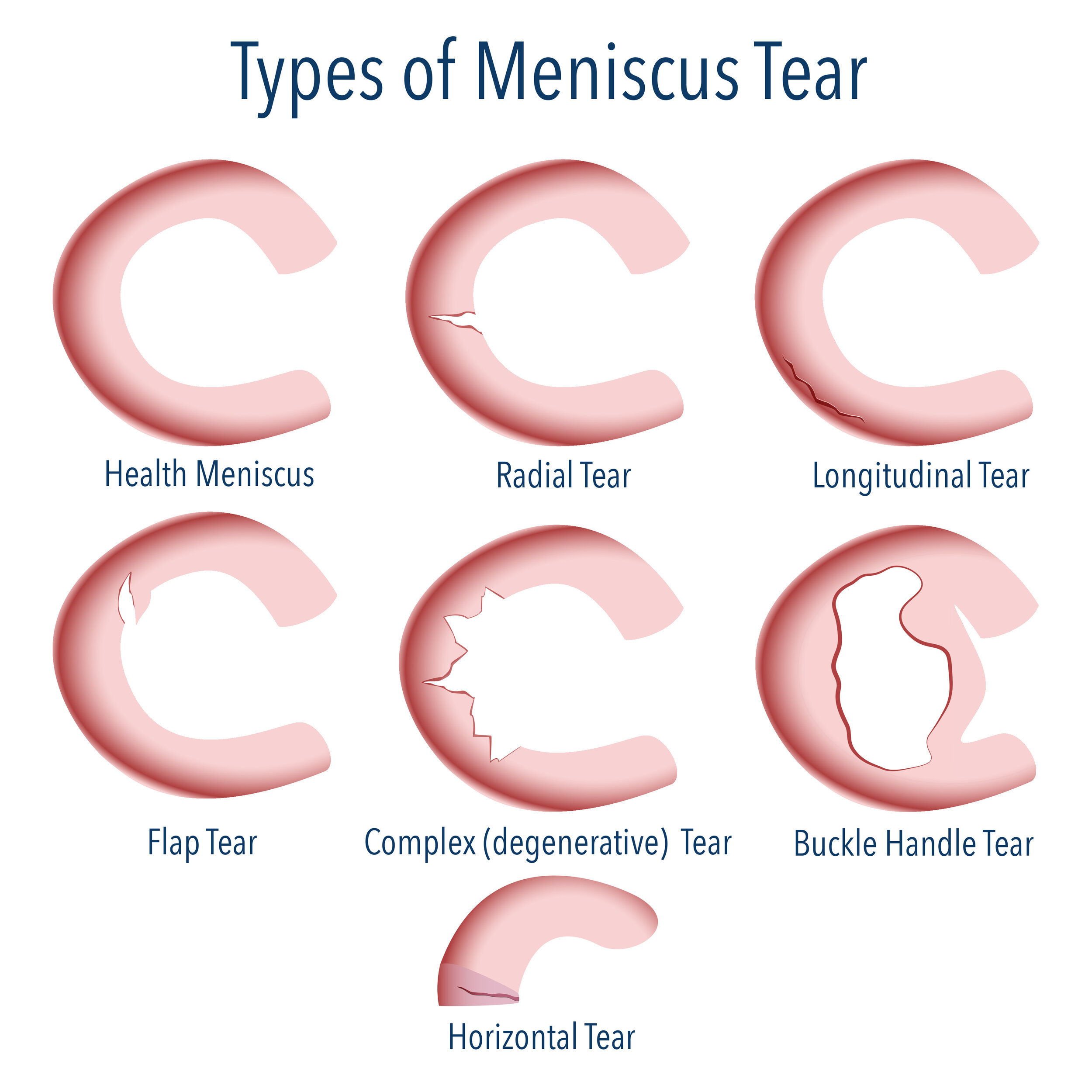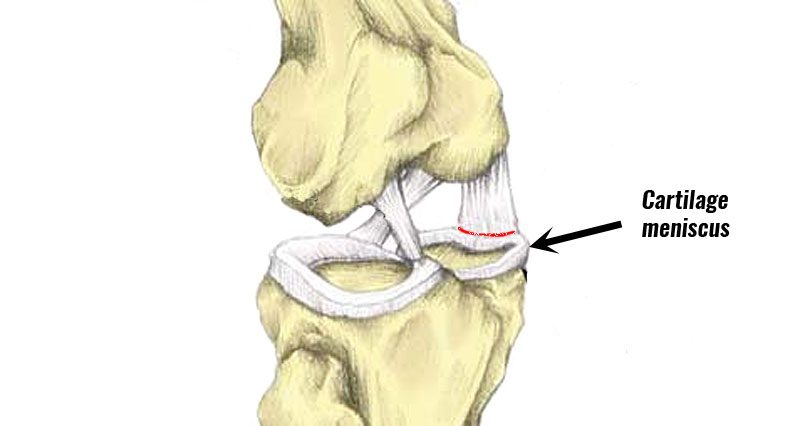Anatomy and Function of the Meniscus

The meniscus is a C-shaped piece of cartilage that acts as a shock absorber in the knee joint. It’s like a rubber cushion that helps protect the bones and ligaments from wear and tear. Think of it like the rubber ring in a bicycle tire, keeping everything smooth and stable.
Location and Structure
The meniscus sits between the femur (thigh bone) and the tibia (shin bone). There are two menisci in each knee: the medial meniscus on the inner side and the lateral meniscus on the outer side. These menisci are made of tough, rubbery cartilage that can withstand a lot of pressure. They are thicker on the outer edge and thinner on the inner edge, which helps them to conform to the shape of the knee joint.
Role of the Meniscus, Meniscus tear
The meniscus plays a crucial role in knee function. It helps to:
- Cushion the joint: The meniscus absorbs shock and reduces the pressure on the knee joint, especially during activities like running, jumping, and squatting. Imagine trying to jump on a hard surface without any padding; it would be painful, right? The meniscus acts as that padding, making movement smoother and less stressful.
- Stabilize the knee: The meniscus helps to keep the knee joint aligned and stable, preventing the femur from sliding off the tibia. Think of it like a stabilizing ring in a well, preventing the bucket from tipping over. The meniscus keeps the knee in its proper position.
- Distribute load: The meniscus helps to spread the weight evenly across the knee joint, reducing the stress on any one area. It’s like a weight-bearing mat that distributes the load, preventing any one spot from getting overloaded.
Types of Meniscus Tears
Meniscus tears can happen in different ways, depending on the location and severity of the tear. Some common types of meniscus tears include:
- Horizontal tear: This type of tear runs across the width of the meniscus, like a horizontal cut.
- Radial tear: This tear runs from the outer edge of the meniscus towards the inner edge, like a spoke on a wheel.
- Oblique tear: This tear runs diagonally across the meniscus, like a diagonal cut.
- Degenerative tear: This type of tear occurs due to wear and tear over time, especially in older individuals. It’s like a crack in a tire that gets worse with use.
Causes and Risk Factors

A meniscus tear is a common knee injury that can occur due to various factors, ranging from sudden trauma to gradual wear and tear. Understanding the causes and risk factors associated with meniscus tears is crucial for prevention and effective treatment.
Common Causes
Meniscus tears can be caused by a variety of factors, including:
- Sports Injuries: Activities that involve twisting, pivoting, or sudden changes in direction, such as football, basketball, and skiing, are common culprits. Imagine this: You’re playing basketball, going for a layup, and BAM! Your knee twists, and you hear a pop. That’s a meniscus tear waiting to happen.
- Age-Related Degeneration: As we age, the meniscus naturally weakens and becomes more susceptible to tears. Think of it like an old tire – it’s more prone to punctures. This is why older individuals are more likely to experience meniscus tears, even from minor incidents.
- Trauma: Direct impacts to the knee, such as a fall or a car accident, can also lead to meniscus tears. You know, like when you’re trying to be a hero and jump off a wall, but land awkwardly on your knee? Yeah, that’s a recipe for disaster.
Risk Factors
Certain factors increase the likelihood of developing a meniscus tear. Here are some key risk factors:
- Age: As mentioned earlier, the meniscus weakens with age, making older individuals more susceptible to tears. Remember, age ain’t nothin’ but a number, but it does play a role in knee health.
- Activity Level: Individuals who participate in high-impact sports or engage in physically demanding activities are at a higher risk. Think of it like this: The more you use it, the more likely it is to wear down. But hey, at least you’re staying active, right?
- Previous Knee Injuries: If you’ve had a previous knee injury, your meniscus may be more vulnerable to tears. It’s like a scar – it’s a reminder of a past injury, and it makes you more susceptible to future problems.
Mechanisms of Injury
Meniscus tears typically occur due to specific mechanisms of injury:
- Twisting: Sudden twisting or rotating movements of the knee, often while bearing weight, can tear the meniscus. Imagine trying to spin a basketball on your finger – it’s a delicate balance, and one wrong move can cause a tear.
- Pivoting: Sudden pivoting or changing direction while the foot is planted can also lead to a meniscus tear. You know, like when you’re playing soccer and trying to juke your opponent, but your knee gives way. Ouch!
- Direct Impact: A direct blow to the knee, such as a fall or a collision, can cause a meniscus tear. This is like when you’re playing dodgeball, and someone throws the ball directly at your knee. Not a good look.
Symptoms and Diagnosis: Meniscus Tear

A meniscus tear can be a real pain, literally. It’s like your knee is saying, “Oi, mate, I’m not feeling too good!” The symptoms can vary depending on the severity of the tear, but there are some common signs that might make you think, “Hmm, this doesn’t feel right.”
Common Symptoms
The symptoms of a meniscus tear can be quite varied, but some of the most common ones include:
- Pain: This is often the first symptom you’ll notice. It might be a sharp, stabbing pain that comes on suddenly, or it could be a dull, aching pain that gets worse with activity. The pain may be located on the inside or outside of the knee, or it may be felt in the back of the knee.
- Swelling: The knee might swell up after the injury, and it can take a few days for the swelling to go down.
- Clicking or Popping: You might hear or feel a clicking or popping sound in your knee when you bend or straighten it. This can be a sign that the torn meniscus is getting caught in the joint.
- Locking: The knee might suddenly lock in place, making it difficult or impossible to straighten or bend the leg. This is usually a sign of a more severe tear.
- Stiffness: The knee may feel stiff and difficult to move, especially after a period of rest.
- Difficulty Walking: It can be hard to put weight on the injured leg, especially when going up or down stairs.
Diagnostic Methods
It’s important to see a doctor if you think you might have a meniscus tear. They will be able to examine you and order any necessary tests to confirm the diagnosis.
Physical Examination
Your doctor will start by asking you about your symptoms and how the injury occurred. Then, they’ll perform a physical examination of your knee. They’ll check for tenderness, swelling, and range of motion. They’ll also perform some special tests to assess the stability of your knee and check for signs of a meniscus tear.
Imaging Tests
If the physical examination suggests a meniscus tear, your doctor may order imaging tests to confirm the diagnosis.
- MRI (Magnetic Resonance Imaging): An MRI is the most accurate way to diagnose a meniscus tear. It uses magnetic fields and radio waves to create detailed images of the soft tissues in your knee, including the meniscus.
- X-rays: While X-rays are primarily used to look at bones, they can sometimes help rule out other conditions, such as a fracture.
Arthroscopy
In some cases, your doctor may recommend an arthroscopy to diagnose and treat a meniscus tear. This procedure involves inserting a small camera and surgical instruments into the knee joint through tiny incisions. This allows the doctor to directly visualize the meniscus and other structures in the knee. It also allows them to repair or remove the torn portion of the meniscus if necessary.
Table of Symptoms and Potential Causes
| Symptom | Potential Causes |
|---|---|
| Pain | Meniscus tear, ligament injury, arthritis, bursitis |
| Swelling | Meniscus tear, ligament injury, arthritis, infection |
| Clicking or popping | Meniscus tear, ligament injury, loose bodies in the joint |
| Locking | Meniscus tear, ligament injury, loose bodies in the joint |
| Stiffness | Meniscus tear, ligament injury, arthritis |
| Difficulty walking | Meniscus tear, ligament injury, arthritis, pain |
A meniscus tear, a common knee injury, often occurs due to sudden twisting or forceful impact. The meniscus, a C-shaped piece of cartilage, acts as a shock absorber and stabilizer within the knee joint. Understanding the roles of each player on the vikings depth chart is crucial for a team’s success, just as a healthy meniscus is essential for proper knee function.
Similarly, a tear in the meniscus can lead to pain, swelling, and instability, requiring careful management and rehabilitation for a full recovery.
A meniscus tear, a common knee injury, occurs when the C-shaped cartilage that cushions the knee joint is torn. This can happen due to a sudden twisting motion or direct impact, often leading to pain, swelling, and difficulty with movement.
Understanding the roles of each player on a team is crucial for success, just like knowing how each part of the knee works together. For instance, you can explore the vikings depth chart to see how the team is structured.
Similarly, the meniscus acts as a vital support system for the knee, and its tear can significantly impact an athlete’s performance.
